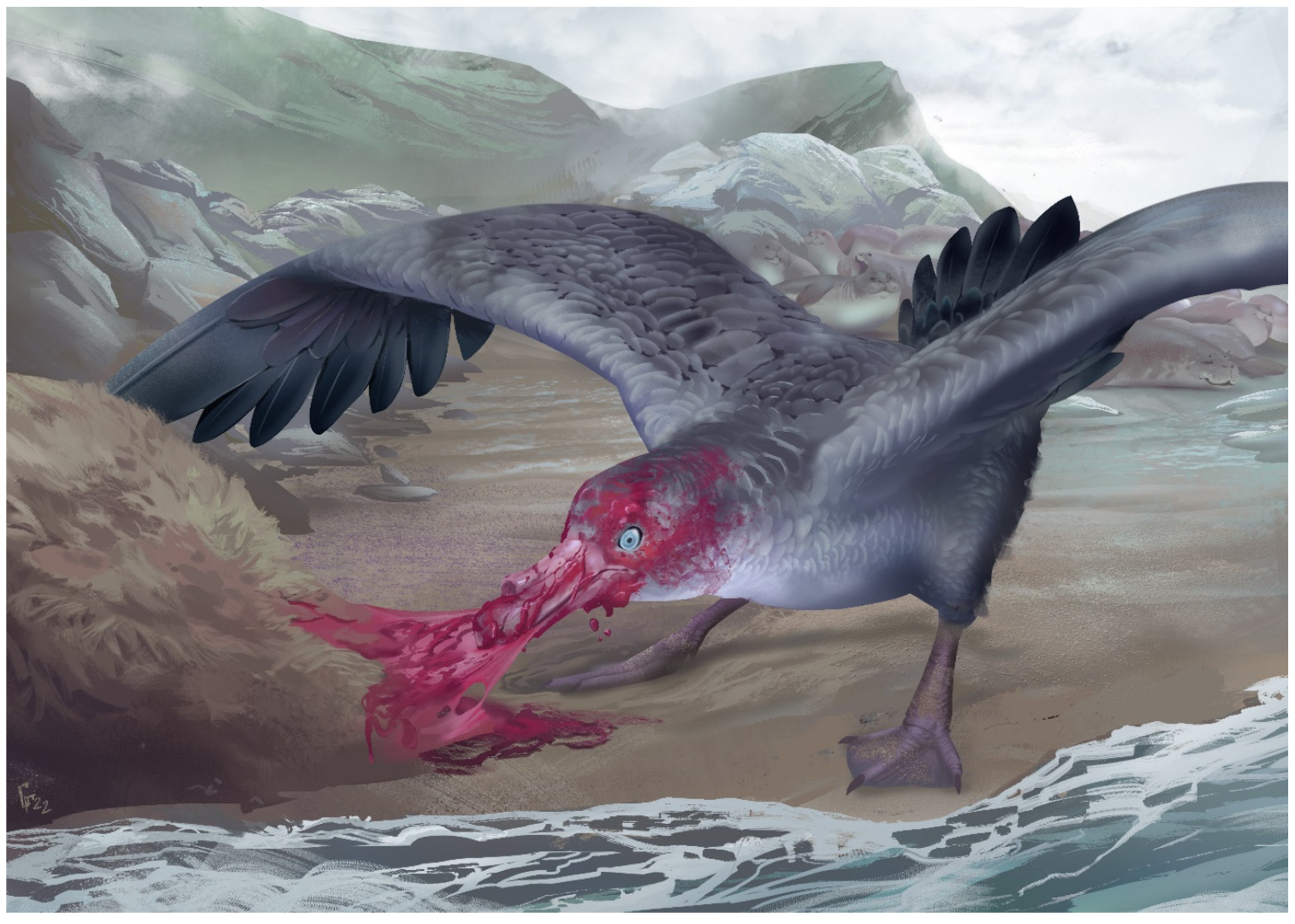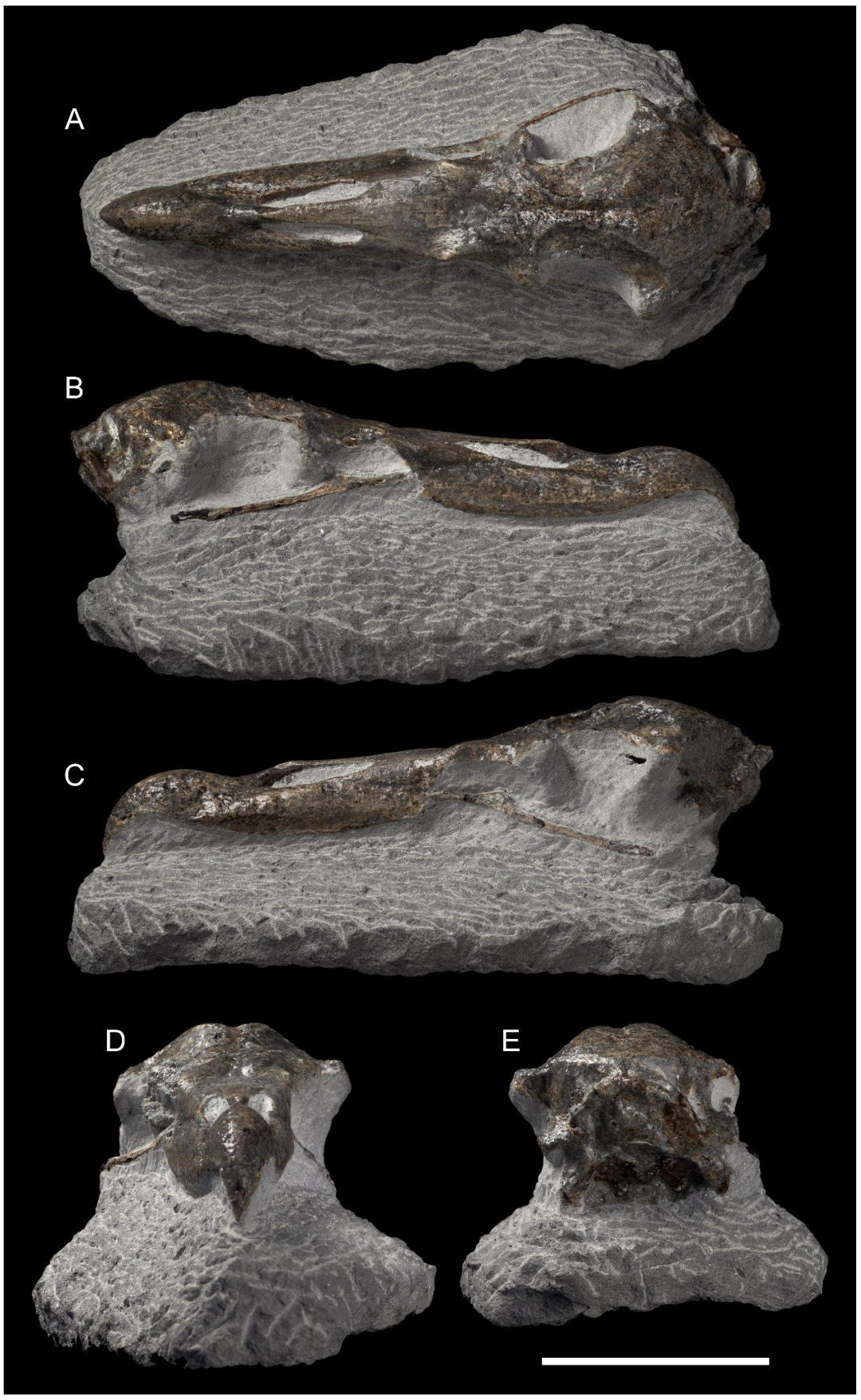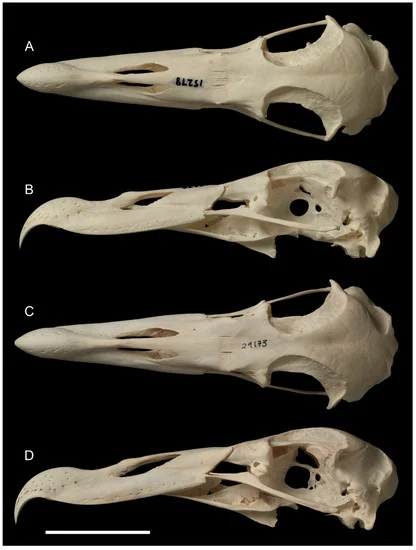 An artistic impression of Macronectes tinae by Simone Giovanardi, © Te Papa
An artistic impression of Macronectes tinae by Simone Giovanardi, © Te Papa
New Zealand fossil-hunter Alistair Johnson has added a new species of giant petrel to the list of those he has discovered along the South Taranaki coast over the past 15 years.
Named in honour of his late partner, Tina King, Macronectes tinae was found by Johnson in sediments from a geologic formation known as the Tangahoe Formation. The wide band of layered sedimentary rock dates from the Pliocene and was, when it formed, below sea level some 3.4 to 3.0 million years ago. Exposed cliff faces at its western end have proved a rich source of marine fossils.
The near complete skull and the fragmentary left humerus of the newly described giant petrel is the first reported Macronectes fossil.
 Skull (holotype, NMNZ S.048502) of Macronectes tinae sp. nov., partially embedded in matrix, in different views; scale bar = 5 cm. (A) Dorsal view. (B) Lateral view (right). (C) Lateral view (left). (D) Anterior view. (E) Caudal view
Skull (holotype, NMNZ S.048502) of Macronectes tinae sp. nov., partially embedded in matrix, in different views; scale bar = 5 cm. (A) Dorsal view. (B) Lateral view (right). (C) Lateral view (left). (D) Anterior view. (E) Caudal view

An image of the skulls (except mandible) of Macronectes spp.; scale bar = 5 cm. (A,B) M. giganteus, NMNZ OR.015278. (C,D) M. halli, NMNZ OR.029173; photograph by Jean-Claude Stahl (NMNZ)
Giant petrels are the largest birds in the family Procellariidae and are represented by two present-day species, both listed as of globally Least Concern; the Southern Macronectes giganteus; and the Norther M. halli. Alhough morphologically similar, Macronectes tinae was a smaller bird than its living relatives.
“The skull is diagnosed by its overall smaller size, a proportionately longer apertura nasi ossea, and potentially by a shorter os supraocciptale. The humerus is diagnosed from both species by a proportionately less deep shaft, a more prominent medial portion of the epicondylus ventralis, and a larger and fusiform fossa medialis brachialis.”
Johnson also has a fossil named after him in a small albatross he found in 2011, Aldiomedes angustirostris .“Al” in relation to his name and “diomedes” after the Greek mythological figure from whence the albatross family was named.
The fossil has been added to the collection of the Te Papa and Canterbury Museum in Wellington and Johnson, as has been the case for his previous finds, has been gifted a replica in its place.
A paper on the newly described Macronectes tinae published open access in the journal, Taxonomy can be accessed, here, or find out more about Alistair Johnson and his fossil hunting in Taranaki, in an article by the New Zealand media outlet, Stuff.
References:
Naish, T. R., Wehland, F., Wilson, G. S., Browne, G. H., Cook, R. A., Morgans, H. E. G., Rosenberg, M., King, P.R., Smale, D., Nelson, C.S., Kamp, P.J.J., & Richetts, B. 2005. An integrated sequence stratigraphic, palaeoenvironmental, and chronostratigraphic analysis of the Tangahoe Formation, southern Taranaki coast, with implications for mid-Pliocene (c. 3.4–3.0 Ma) glacio-eustatic sea-level changes. Journal of the Royal Society of New Zealand. 35(1&2), 151-196. https://doi.org/10.1080/03014223.2005.9517780
Tennyson, A.J.D., & Salvador, R.B.A. 2023. New Giant Petrel (Macronectes, Aves: Procellariidae) from the Pliocene of Taranaki, New Zealand. Taxonomy. 3, 57-67. https://doi.org/10.3390/taxonomy3010006
24 February 2023

 Français
Français  English
English  Español
Español